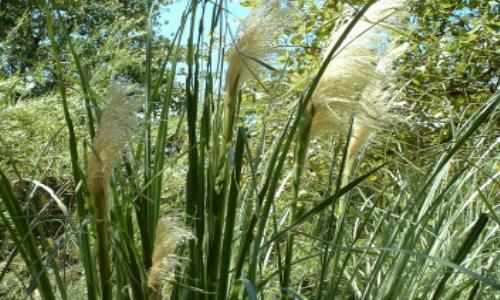|
|
Our Pampas Grass Articles and Photos by Nita Holstine More Photos at bottom of this page... |
|
|
Our Pampas Grass Articles and Photos by Nita Holstine More Photos at bottom of this page... |
| 07-25-06
Update on what I have learned about Pampas Grass... I did try to get the "seeds" to sprout and they would not. I had 3 people write and tell me that they would not and they didn't. But then when I tried to give away some of the plants, I had only one taker. To work with the plants is like sticking your hands into razor blades. Even the dry leaves cause damage. Most of our winters are so mild that the plants do not die back. Read over what is written below. They could be completely dug up and divided but where would I put so very many plants??? It did take about 3 years before the original plants "bloomed" but well worth the wait. The main mass has spread to become dozen and dozen of plants. Each clump looks different from the other, probably male and female but both are the white/cream color. See photos below... This past year, the grasshoppers devastated the plants, ate them down to near nothing. We had no plumes and I worried they would not survive. This year, I pulled out dead pieces and there is plenty of new growth. But no plumes. For the lady planting her new plants, dig a nice 2 foot pit. That's 2 foot diameter and deep. Use a compost/rich soil to give the plants a good start. Spacing is important. Only one plant per pit, plants must be 5 foot apart. This seems a lot when they are small but they grow up BIG and will sure need the space. From all that I have read, they can stand the all day direct sun. The spot mine are in is partial shade but the next I plant out will go into full sun. When the plants are small and young, water every few day. As they are established, once every two weeks is plenty.
|
|
10-01-03 This is a good time to start a new section. I had been wondering just how to go about dividing the now huge clumps of Pampas Grass, so I went gathering information. The first site I found was the National Park Service. Wow, they consider Pampas Grass a nuisance and say they are unwanted and use words like control instead of propagation and care. But they have Redwood trees they need to pamper and Pampas Grass is not on their list of friendly plants. About 5 or six years ago, we bought two tiny plants. Mail order along with the Wall of China trees. The only information I could find on Pampas Grass back then said to regularly dig up the entire clump and divide, discarding the dead outside pieces. The Dr. Bob Black website gave the very best information for using and enjoying the plant. I now know that I don't need to dig it up but I already knew the part about wearing gloves and long sleeves. Ouch, don't pull on a leaf that is not loose, you will cut your fingers before you get that tough leaf off. Propagation is by seeds. So they say to control the spread, don't let the seeds be scattered, that the seeds sprout readily. I can do that. The plumes last year were eaten up so fast it was hard to believe they'd been there at all. The wild turkeys fight to eat the seeds, leaping ten foot into the air to reach the plumes. What a grand sight. No seeds but my little tiny plants were finally growing big. The grasshoppers did some big time devastation last year but nothing so serious this year. A group of about 6 turkeys came toward the plants into the yard about a week ago. I was watching out the kitchen window and had to go and shoo them away. They were already within 25 feet of Max and he was waiting quietly, in the shadows of his house. I actually hope to figure a way to test the seeds and see if they seem ripe, dry. I didn't read anything but vague references. One site author seemed to think that they just popped up from the roots but another seemed more certain that it was the seeds. The problem will be to get up to the 8 or 9 foot height. The following pictures were taken about a month ago. Several authors mention that you know fall is coming when the Pampas Grass send up their plumes. It was actually about two weeks before the days started getting shorter that I first noticed a stalk. |
|
|

